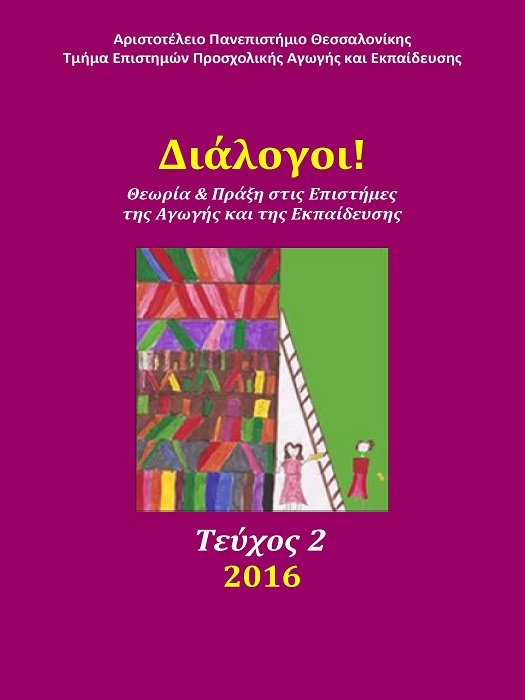Ο κίνδυνος της αποφυγής του ρίσκου στο παιχνίδι

Περίληψη
Το ρίσκο αποτελεί μια σημαντική διάσταση του παιχνιδιού. Παράλληλα θεωρείται μέσο μάθησης, εξοικείωσης με το περιβάλλον και προώθησης της κινητικής, γνωστικής, κοινωνικής ανάπτυξης των παιδιών. Με την εμπλοκή τους σε ριψοκίνδυνες δραστηριότητες, τα παιδιά μαθαίνουν να διαχειρίζονται δυσκολίες και προετοιμάζονται για την αυτόνομη και ασφαλή λειτουργία τους. Ο περιορισμός του ριψοκίνδυνου παιχνιδιού στη σύγχρονη δυτική κοινωνία απασχολεί ιδιαίτερα τους επιστήμονες που ασχολούνται με την αγωγή των παιδιών. Όταν τα παιδιά δεν έχουν ευκαιρίες για αναπτυξιακά κατάλληλα ρίσκα, γίνονται πιο ανασφαλή, εξαρτημένα και ευάλωτα σε αντιξοότητες. Επομένως η υπερβολική προστασία των παιδιών και η αποφυγή του ρίσκου εμπεριέχει σοβαρότερους κινδύνους για την υγιή ανάπτυξή τους από τις πιθανές συνέπειές του. Στο άρθρο αυτό σχολιάζεται η σημασία του ρίσκου στο πλαίσιο του παιχνιδιού, οι παράγοντες που συμβάλλουν στον περιορισμό του και οι δυνατότητες επανένταξής του στη σύγχρονη κοινωνική πραγματικότητα. Υποστηρίζεται η αναγκαιότητα κατανόησης της συμβολής τόσο των κοινωνικών όσο και των ατομικών παραμέτρων στην αποτροπή του ρίσκου, αλλά και στην ενθάρρυνση των παιδιών να αναλαμβάνουν ρίσκα σε ένα πλαίσιο ασφάλειας. Τέλος επισημαίνεται η ανάγκη διεύρυνσης της έννοιας του ρίσκου με την αναφορά σε ριψοκίνδυνες δραστηριότητες που σχετίζονται όχι μόνο με την σωματική αλλά και την ψυχική υγεία των παιδιών.
Λεπτομέρειες άρθρου
- Πώς να δημιουργήσετε Αναφορές
-
Kontopoulou, M. (2016). Ο κίνδυνος της αποφυγής του ρίσκου στο παιχνίδι. Διάλογοι! Θεωρία και πράξη στις επιστήμες αγωγής και εκπαίδευσης, 2, 20–34. https://doi.org/10.12681/dial.10512
- Τεύχος
- Τόμ. 2 (2016)
- Ενότητα
- Ειδικό Θέμα

Αυτή η εργασία είναι αδειοδοτημένη υπό το CC Αναφορά Δημιουργού – Μη Εμπορική Χρήση – Παρόμοια Διανομή 4.0.
Οι συγγραφείς των άρθρων που δημοσιεύονται στο Διάλογοι! Θεωρία και Πράξη στις Επιστήμες Αγωγής και Εκπαίδευσης διατηρούν τα δικαιώματα πνευματικής ιδιοκτησίας επί των άρθρων τους, δίνοντας στο περιοδικό το δικαίωμα της πρώτης δημοσίευσης. Άρθρα που δημοσιεύονται στο Διάλογοι! Θεωρία και Πράξη στις Επιστήμες της Αγωγής και Εκπαίδευσης διατίθενται με άδεια Creative Commons 4.0 και σύμφωνα με την άδεια μπορούν να χρησιμοποιούνται ελεύθερα, με αναφορά στον/στη συγγραφέα και στην πρώτη δημοσίευση για μη κερδοσκοπικούς σκοπούς και με δικαίωμα τροποποίησης μόνον με παρόμοια διανομή (αν αναμείξετε, τροποποιήσετε, ή δημιουργήσετε πάνω στο υλικό, πρέπει να διανείμετε τις δικές σας συνεισφορές υπό την ίδια άδεια όπως και το πρωτότυπο).
To Τμήμα Επιστημών Προσχολικής Αγωγής και Εκπαίδευσης του Αριστοτέλειου Πανεπιστημίου Θεσσαλονίκης και το Εθνικό Κέντρο Τεκμηρίωσης διατηρούν το δικαίωμα να δημοσιεύουν, να αναπαραγάγουν, να παρουσιάζουν στο κοινό, να διανέμουν και να χρησιμοποιούν άρθρα που δημοσιεύονται στο Διάλογοι! Θεωρία και Πράξη στις Επιστήμες Αγωγής και Εκπαίδευσης σε οποιοδήποτε μέσο και μορφή είτε μεμονωμένα είτε ως μέρη συλλογικών έργων, για όλο το χρόνο διάρκειας προστασίας της πνευματικής ιδιοκτησίας και για όλες τις χώρες του κόσμου.
Αυτό περιλαμβάνει ενδεικτικά, και όχι αποκλειστικά, το δικαίωμα δημοσίευσης των άρθρων σε τεύχη του περιοδικού Διάλογοι! Θεωρία και Πράξη στις Επιστήμες Αγωγής και Εκπαίδευσης, αναπαραγωγής και διανομής μεμονωμένων αντιγράφων των άρθρων, αναπαραγωγής ολόκληρων των άρθρων σε άλλη έκδοση του Τμήματος Επιστημών Προσχολικής Αγωγής και Εκπαίδευσης του Αριστοτέλειου Πανεπιστημίου Θεσσαλονίκης και του Εθνικού Κέντρου Τεκμηρίωσης και αναπαραγωγής και διανομής των άρθρων ή περίληψης αυτών με χρήση πληροφορικού συστήματος αποθετηρίου.


